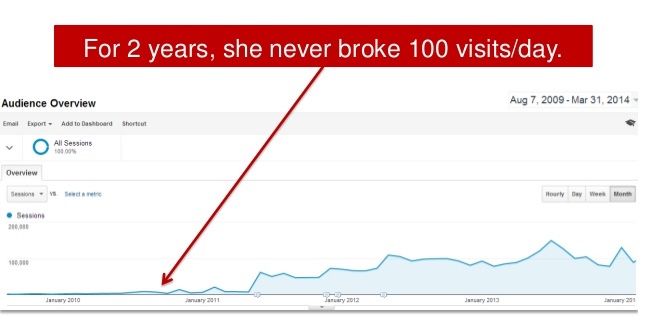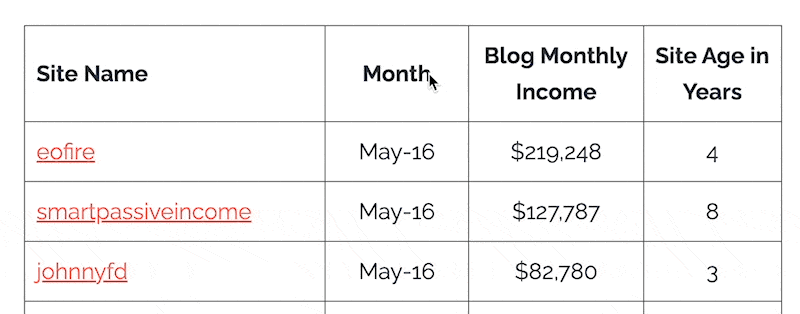Why building a successful blog takes time (but less than you think)
Your blogging goals may be closer than you think.
We’ve seen the stories of successful bloggers and creators attracting audiences, and paydays, in the millions. Many of them appear to be “overnight successes.”
But is this really the case?
Oftentimes, we miss the winding paths that led them into the spotlight. The years of toiling away in anonymity and the foundation of content which made their success possible in the first place.
So, how long does it take to build a following and business online? And how can you know if you’re on the right track?
How long does it take to build a successful blog?
There is no guaranteed time span, that if you commit to, will promise you success. However, there are patterns. As Jim Rohn says,
"Success leaves clues.”
To help identify these patterns, we’ll take a look at a handful of examples from both bloggers and YouTube creators. Why these two categories? Because there is a lot of overlap in how they function:
- Both rely on search keywords for traffic.
- Both can build audiences: bloggers with email subscribers and YouTubers with subscribers (although email is much more effective).
- Both can monetize through ads, sponsorships, digital products, and more.
Example #1: Pinch of Yum
Lindsay and Bjork started a food blog in 2011 while they were both still working full-time jobs. They posted consistently, experimented with different types of content, and slowly began adding income streams, such as ads and products.
Three-and-a-half years later, in the summer of 2014, they were able to leave their jobs and go all-in on their blog. Today, their publication now supports a team of eight people.
Example #2: The Everywhereist
Geraldine started a travel blog as a way to share their experiences publicly. For two years, the blog received nearly zero traffic. But the author was okay with this because they enjoyed the process of creating content.
Then, during the third year, a few articles went viral, which brought mountains of new visitors to their site. And since Geraldine had been posting consistently for years, there was plenty of content for them to explore.
Here’s a snippet of what The Everywhereist’s traffic timeline looks like.


Example #3: Gillian Perkins
YouTuber Gillian Perkins began their journey with a music-focused channel where they shared lessons, product reviews, and tips for aspiring musicians. However, after three years of working on that project, Gillian was ready to invest in something new — and apply all the growth tactics learned along the way.
In only six months, their second channel, a business-focused one, eclipsed the first channel in terms of audience and income.
Example #4: Collection
Finally, a few years ago, blogger Suzi Whitford analyzed 50+ blogs to highlight any patterns found.

They discovered that most blogs surveyed took around four years before they generated significant income, and the most successful ones had been publishing for 6-8 years.
Summary of blog time commitment
Around the 2-year mark, you should have enough content and a large enough audience to begin experimenting with different monetization methods.
For those who want to become full-time content creators, plan to publish consistently for 3-4 years before being able to comfortably make the transition.
Now, these are just patterns, not guarantees. But they do reveal what is possible. In the same time it takes to get a college degree or a promotion at work, you could build an online business you control.
However, you must make sure you’re using that time productively.
How many posts do you need to publish?
Most bloggers and content creators follow a weekly cadence, meaning they publish one new article or video per week.
Some choose to publish more often. This can be a strategy to accelerate growth, or it might be standard in your niche (such as creators who cover trending news stories or livestream and post daily).
For example, The Everywhereist reached 1,000 published posts after 4 ½ years (about two posts per week). YouTuber Lavendaire got their first brand deal after 250 published videos (about three videos per week).
For your first 100 articles, videos, or any other type of content you create, focus on honing your craft. Pay attention to what resonates with people. Develop related technical skills, like customizing a website or video editing. If you adopt this mindset, you'll enjoy the process much more, and the quality of your content will improve much quicker.
Stack the odds in your favor
Growing a blog takes time, and only a small percentage of creators stay in the game long enough to win. That means if you're willing to persist, your odds of achieving a successful blog are very good.
There's an inevitable element of needing to show up consistently, over time. You can apply the same principle to pretty much any creative endeavour (art, music, photography), learning of a new skill (like yoga or learning to code), or to building a business.
A few more tips for increasing your odds are:
- Don’t pick a niche too soon. Explore than exploit.
- Choose a subject and medium (articles, video, etc.) you enjoy because you're going to spend a lot of time in them.
- Focus on building an audience before you worry about how to monetize it.
- Make yourself a schedule and stick to it. If there is any secret to success, it's showing up consistently.
- Adopt a growth mindset. Your content can, and will, get better over time.
A marathon versus a garden
Many people use the marathon analogy when describing what it takes to build a creative business online. Though useful, a better one is a vegetable garden.
Growing a garden not only requires time and patience but care and awareness. There are different seasons involved and a lot to learn. But over time, you'll start to notice signs of life peeking through the dirt. And eventually, the plants you sustained will come to produce things that sustain you.
Before long, people will look at what you’ve built and wonder how you achieved your “overnight success” too.






